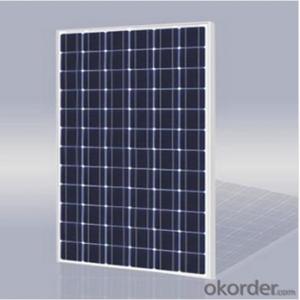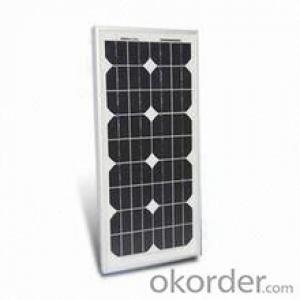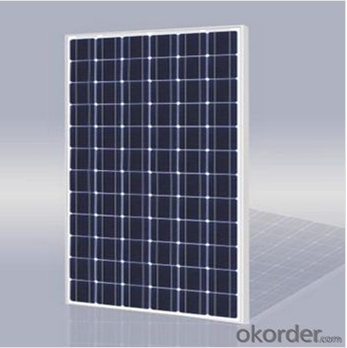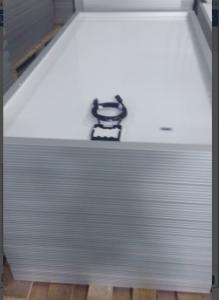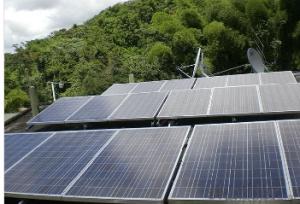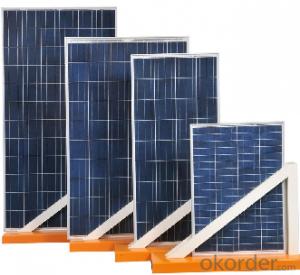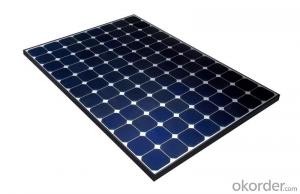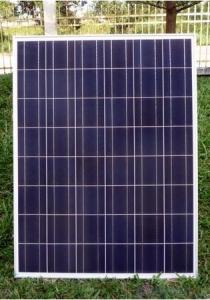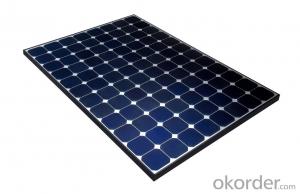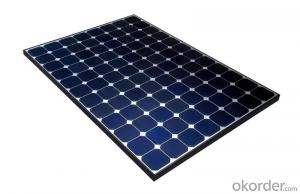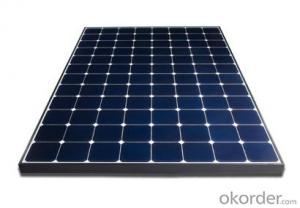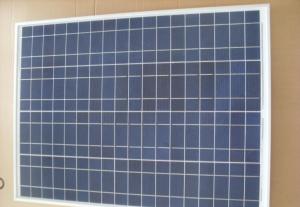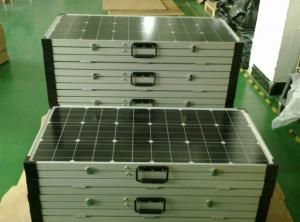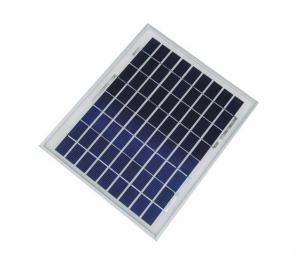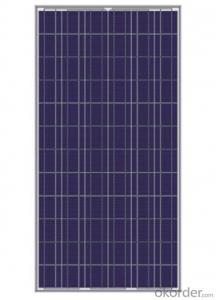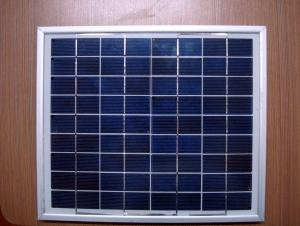Reno Solar Panels - CNBM Poly 220W Solar Panel with TUV UL CE Certificate for Residential
- Loading Port:
- Shanghai
- Payment Terms:
- TT OR LC
- Min Order Qty:
- 100 watt
- Supply Capability:
- 1000 watt/month
OKorder Service Pledge
OKorder Financial Service
You Might Also Like
Specification
CNBM Poly 220W Solar Panel with TUV UL CE Certificate For Residential
Introduction
Electrical connections are made in series to achieve a desired output voltage and/or in parallel to provide a desired current capability. The conducting wires that take the current off the modules may contain silver, copper or other non-magnetic conductive [transition metals]. The cells must be connected electrically to one another and to the rest of the system. Externally, popular terrestrial usage photovoltaic modules use MC3 (older) or MC4 connectors to facilitate easy weatherproof connections to the rest of the system.
Each module is rated by its DC output power under standard test conditions, and typically ranges from 100 to 365 watts. The efficiency of a module determines the area of a module given the same rated output – an 8% efficient 230 watt module will have twice the area of a 16% efficient 230 watt module. There are a few solar panels available that are exceeding 19% efficiency. A single solar module can produce only a limited amount of power; most installations contain multiple modules. A photovoltaic system typically includes a panel or an array of solar modules, a solar inverter, and sometimes a battery and/or solar tracker and interconnection wiring.
Micro-inverted solar panels are wired in parallel which produces more output than normal panels which are wired in series with the output of the series determined by the lowest performing panel (this is known as the "Christmas light effect"). Micro-inverters work independently so each panel contributes its maximum possible output given the available sunlight.[6
A solar cell, or photovoltaic cell (in very early days also termed "solar battery"[1]– a denotation which nowadays has a totally different meaning, see here), is an electrical device that converts the energy of light directly into electricity by thephotovoltaic effect, which is a physical and chemical phenomenon.[2] It is a form of photoelectric cell, defined as a device whose electrical characteristics, such as current, voltage, or resistance, vary when exposed to light. Solar cells are the building blocks of photovoltaic modules, otherwise known as solar panels.
Solar cells are described as being photovoltaic irrespective of whether the source issunlight or an artificial light. They are used as a photodetector (for example infrared detectors), detecting light or other electromagnetic radiation near the visible range, or measuring light intensity.

Suggested application
Home lighting business lighting,
Garden lighting, pavement lighting
Farmer household lighting
Decorative water pump
Traffic signal lighting
Industry area
Business area
Solar Power Plant
Product feature
Modules are made of Monocrystalline or Polycrystalline Silicon cell.
Materials and color of the solar panel frame: Clear anodized aluminum alloy type 6063T5 Universal frame; Silver-white color;
The output connection gathers the coupling: Selects conforms to the IEC-612615; 2005, class II, IEC61730 international standard; Airtight waterproofing binding clamp;
Module seal structure: The surface is thick, the high diaphanous rate armored glass with solar cell board special-purpose 3.2mm becomes after the high temperature lamination craft. The back selects has waterproof and anti- aged performance fine TPT materials. The entire block battery board has, the waterproofing, the anti- aging airtight and so on the fine performance;
Power tolerance: +/-3%
Packaging
International standard cartons (according to the requirements of customers)
- Q: What are the financial benefits of installing solar panels?
- Installing solar panels can provide several financial benefits. Firstly, solar panels allow homeowners to generate their own electricity, reducing their reliance on the grid and potentially lowering their monthly utility bills. Additionally, excess energy produced by solar panels can be sold back to the grid, resulting in potential income through net metering or feed-in tariffs. Moreover, investing in solar panels can increase the value of a property, making it more attractive to potential buyers and potentially leading to higher resale prices. Finally, solar panels can also qualify for various tax incentives, grants, or rebates, further reducing the initial installation costs and providing additional financial savings.
- Q: How do solar panels affect the grid during times of high electricity demand?
- Solar panels can help alleviate the strain on the grid during times of high electricity demand by generating clean and renewable energy directly from the sun. When solar panels produce surplus electricity, it can be fed back into the grid, increasing its supply and reducing the need for traditional power sources. This helps stabilize the grid and meet the increased demand while also reducing the reliance on fossil fuel-based power plants.
- Q: How much space do solar panels require?
- The space required for solar panels can vary depending on factors such as the size and efficiency of the panels. On average, a typical residential solar panel system can require around 100-400 square feet of roof space per kilowatt of installed capacity. However, advancements in technology have led to the development of more efficient panels that can generate more electricity in less space.
- Q: I want to buy a solar panel kit to run my central AC unit. it is a 3 ton unit. Can I do this? The electric rates in the Chicago area are skyrocketing and I can't keep paying 350 dollar electric bills during the spring and summer months
- I know that in Texas we wouldn't even try to run an air-conditioner on a generator without at least a 6,000 watt generator and we would prefer a 0,000 watt generator. The calculator on the Kohler website says it'll be 7,500 watts. At $5 per watt to install a solar photovoltaic system and assuming you also need to run it through the night and taking into account that an inverter can be as bad as 60% efficient, you're talking about $87,500 just to run your AC for 25 years. The first step in going solar is to significantly reduce your energy use. You're not going to maintain your current energy use on solar, at least not cost effectively. If you did want to run an AC on solar power, you may want to look at absorption air conditioning and use evacuated tube solar thermal collectors instead but don't expect it to be cheap and it usually only augments the use of natural gas in the absorption chiller.
- Q: I was thinking of having some installed on our rooftop and was wondering if it would be worth the cost? The house is located in Sac, Cali. The panels would face the sun 2 months out of the year and in the summer roughly 4 hours of straight sun.
- You can log in alibaba,i purchased about 20000watts 2 years ago and solar panels work efficiency is fairly high. I hope my answer help you !
- Q: How do solar panels affect the overall sustainability of a building?
- Solar panels positively affect the overall sustainability of a building by reducing reliance on non-renewable energy sources and decreasing carbon emissions. They generate clean and renewable energy from the sun, reducing the building's environmental footprint and contributing to a greener future. Additionally, solar panels can lower energy costs, increase energy efficiency, and provide energy independence, making the building more resilient and sustainable in the long run.
- Q: Properties of solar panel?I know this is too general,but i am to write a report on the materials used to make solar panels,and i am to include the physical, mechanical ,and chemical properties of the materials.It's just too general,such that i am lost.There are so many types of solar panels.So i hope some experts on this subject can give me a general guide lines ,maybe the tensile strength ?as much as you can please.
- Solar power Power Can Help Preserve You Money The cost of power is going up, and will only keep going up. Reaction Solar power Power Systems will help you save a large number of kWh each season by utilizing screen technology. Power created by your program are kilowatts you don't need to pay for! Every electricity program will make a number of Small-scale Technology Accreditations (STCs) upon purchase based on the size of the program and the location where it will be set up. These STCs have a market value and can be exchanged and marketed just like stocks. Power created by your solar PV program can be marketed to the lines for a top quality cost via Feed-in charges. These feed-in charges are different in every state, but the primary idea is te same, to compensate entrepreneurs of small-scale power creation. You are eligible to sell some or all of the ability you produce for more than you would normally pay for it. Would you like to decrease costs with solar power? Contact Reaction and get it done these days. Solar Power Can Help Preserve The Environment click to enlarge Producing usable direct sunlight generates no dangerous pollutants. Every season coal-fired power vegetation belch a large number of loads of as well as contamination into the weather so we can run our refigerators, toaster ovens, and have hot bathrooms. Taking your power form your own ceiling means you are no longer leading to that contamination. In fact, power companies will be paying you for electricity! Help Sydney accomplish its 5% green energy focus on by 2020 and international objectives of 20%, by changing to solar power and decreasing your own effect on international warming. Compared with other small-scale turbines, solar power is completely quiet. Turn the team radiation into power without making a audio and decrease environmental disturbance.
- Q: Need solar panel info with dimensions and also the total cost of the whole equipment for setting up of the required solar panels for a 2-story home
- There are many, upon many variations of equipment needed for a complete solar home. I would call several contractors in your area that deals with it and get estimates. You have to look at what your wattage diet is at your home. How many watts are you using for your AC and heat. Which can vary by age, efficiency, insulation of home, etc. Look at your electric bill for a normal summer month and a normal winter month, then estimate your heating and cooling (Sometimes can be as much as 70% of the bill). You will see on your bill your toal kilowatt hours. ( Kilowat = 000 Watts) Solar systems can start as low as $2.00/watt, but can rapidly approach $20.00/watt depending on the difficulty of application etc.... Here is the great thing, in many areas of the country there may be rebates from the county or state. And what you don't use can be fed back into the grid, and you get paid for it. But as always - Call a quailified contractor and get the right system for your home.
- Q: Can solar panels be used in areas with high levels of bird or bat activity?
- Yes, solar panels can be used in areas with high levels of bird or bat activity. However, it is important to take certain precautions to minimize the potential risks to birds and bats. These precautions may include using specific panel designs that reduce the chances of bird or bat collisions, implementing bird or bat deterrent measures, and considering the placement of the panels in areas away from known flight paths or nesting sites. By implementing these measures, solar panels can coexist with bird and bat populations while helping to generate clean, renewable energy.
Send your message to us
Reno Solar Panels - CNBM Poly 220W Solar Panel with TUV UL CE Certificate for Residential
- Loading Port:
- Shanghai
- Payment Terms:
- TT OR LC
- Min Order Qty:
- 100 watt
- Supply Capability:
- 1000 watt/month
OKorder Service Pledge
OKorder Financial Service
Similar products
Hot products
Hot Searches
